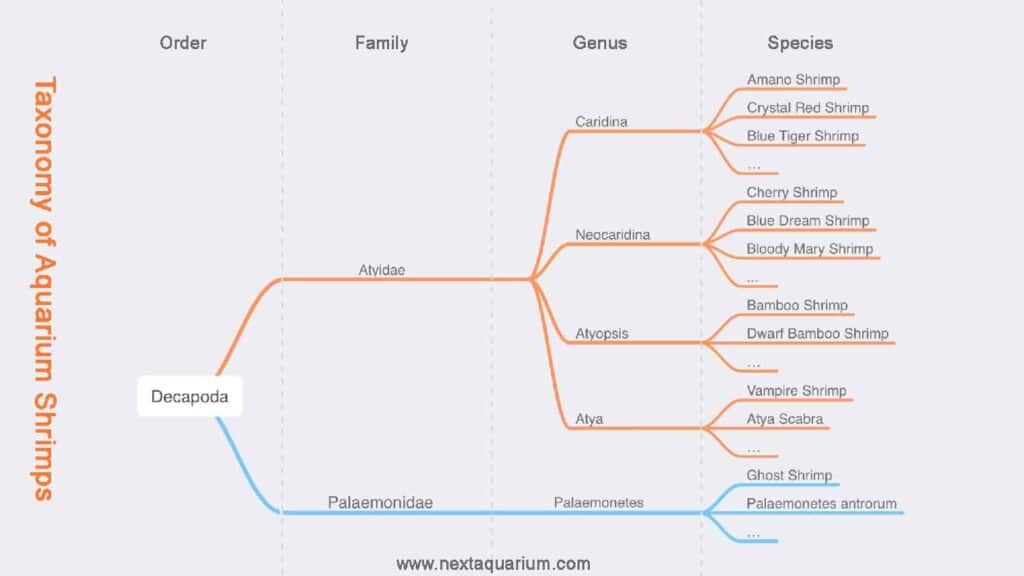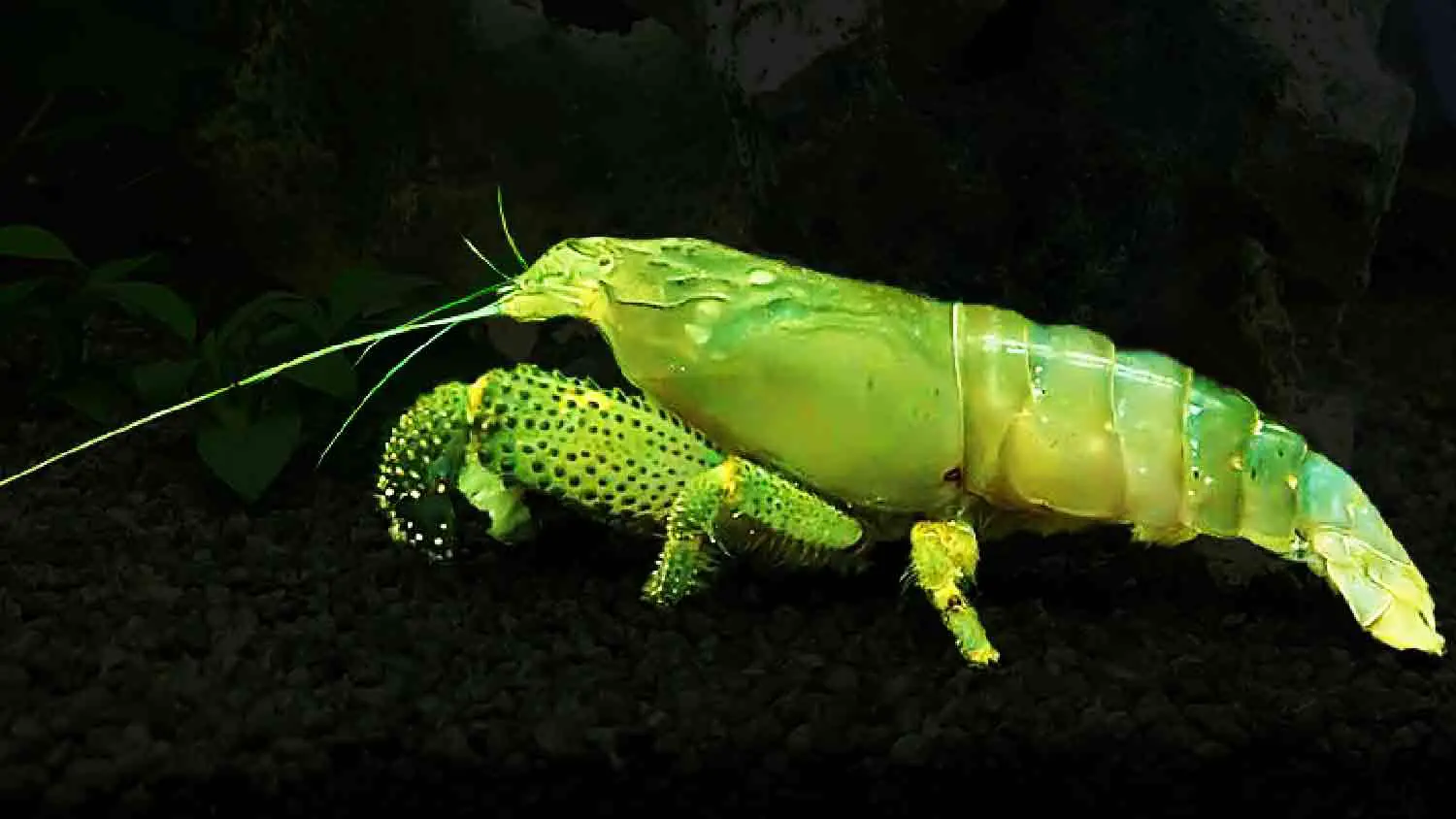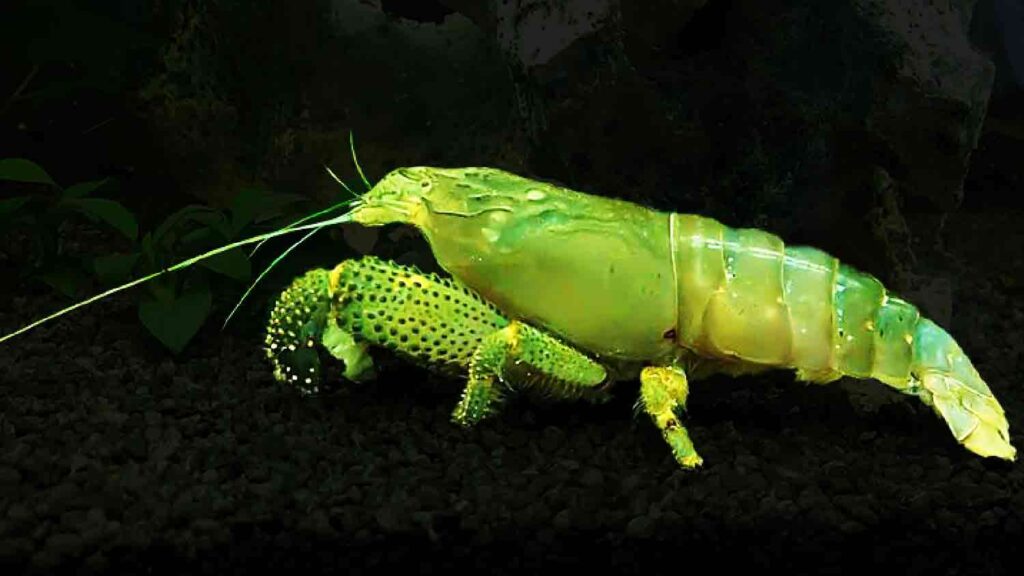Vampire Shrimp (Atya gabonensis) is a filter-feeding shrimp species that has a bold and crayfish-like look. These giant shrimps come in different shades of white, green, blue, gray, and even shades of red. Despite their large and aggressive look and name, these guys are one of the calmest and most peaceful types of shrimps you can find in the hobby. This is because they lack claws to be able to hurt other species.
Around the world, Vampire Shrimp is known by different names like African Fan Shrimp, African Filter Shrimp, Gabon Shrimp, or Viper Shrimp. Regardless of the name, these giant shrimps will bring a different look to your tank.
This vampire shrimp care guide will teach you all the information you need to successfully care for this species.
Vampire Shrimp Overview
Vampire Shrimp is native to parts of Western Africa and South America. These giants are not very common in the aquarium hobby due to the fact that they are slightly hard to find in nature. This makes them slightly more expensive compared to more common types of shrimps.
However, these shrimps are one of the best cleaning creatures you can get for your aquarium. Like Bamboo Shrimps, Vampire shrimps are also filter-feeding creatures that have feather-like claspers (fans) to catch floating particles. But Vampire Shrimps are bulkier and have the looks of a small crayfish.
They are named “Vampire Shrimp” because of the tiny fang-looking objects they have on their legs. But they are not aggressive creatures and do not harm other species. They use these “fangs” to hold themselves to rocks and objects as the areas they live in have slightly fast-moving waters.
Vampire shrimps are one of the largest types of freshwater shrimps you can buy in pet stores. At the same time, they are hardier shrimps that can tolerate harder water parameters. This makes them a perfect type of shrimp for the areas where their tap water is slightly harder.

Appearance

Vampire shrimp are gentle giant shrimps that grow bold and thick. These peaceful freshwater invertebrates develop different colorations depending on the hardness of the lake they are being picked from. They usually come in a shade of red, white, blue, or gray.
Probably the first thing that catches everyone’s attention is their thick body covered with a hard shell and their gigantic 2 front legs. Their hard shell is their main defense mechanism and their thick and scary-looking legs will make predator fish think twice before hunting them.
Instead of claws, Vampire shrimps have fans attached to their front feeding legs. They use these fans to filter the water for any small algae or microorganisms. These fans are transparent feather-like organs that water can pass through them but larger particles will stick.
Their body lacks any patterns or markings but the shell plates will create vertical lines of the body. The legs look like tiny cactuses coming out of the body. This gives them a somewhat scary look.
They also have 6 tentacles that they use to sense pheromones and chemicals in the water to find food. Tentacles are located on their head near the eyes and mouth.
Lifespan
Vampire Shrimp’s lifespan is up to 5 years. For a shrimp, this is a very long time!
These shrimps need pristine water parameters their whole life so they can live their expected life. Things like poor water conditions or a bad diet can lower their lifespan.
There are reports that they lived up to 6 years when they are kept in cooler water and with a quality diet. Higher temperatures will increase their metabolism which will cause them to live shorter lives.
Adult Size
Vampire Shrimp will grow to about 3 inches in length. But there are variants that can grow up to 6 inches. They are usually sold at a smaller size around 2 inches and will grow slowly in your aquarium.
Female vampire shrimps are slightly bigger than males. This is because they are in charge of developing and carrying eggs.
Behavior and Temperament
Vampire Shrimps are one of the calmest types of freshwater shrimps. They are naturally shy and avoid causing any conflicts in the tank. These shrimps are a very good fit for most community tanks as long as the water parameters match what they need.
They will stay in areas where water flow is fast and open their fans to catch any small food particles available in the water. They are super helpful at removing particles floating in the water column.
While they are not territorial species, they seem to enjoy being alone. They usually stay around their favorite spot without bothering other fish or shrimp. If they find a hiding spot that has a good water flow, you might not see them for days. They stay in their hiding spot and catch any food they can filter out.

Vampire Shrimp Care
Caring for Vampire shrimp is super easy. They are one of the strongest types of shrimps you can own when it comes to their tolerance. They can withstand a wide range of water parameters as long as the water is consistent.
That being said, these guys need a stable and mature tank that is well cycled. When water parameters fluctuate they seem to get stressed. Any type of stress and more especially the stress caused by water parameters will cause the shrimp to develop diseases and may even cause death.
Tank Size
Vampire Shrimp can live in a 20-gallon aquarium or bigger. These shrimps are filter feeders so they need to have enough water volume to be able to get all the food they need. need a decent amount of water volume to feed, so the bigger the tank, the better.
If you want to have more vampire shrimps in a single tank, then you must have a bigger tank. Bigger tanks are also much better at keeping the water parameters stable and consistent. Which is a plus point!
Tank Setup
Vampire shrimps love to live in an aquarium that is full of life. So it is important to have them in a mature tank that is established and has enough plants. Plants will give your shrimp hiding spots and provide them with food. At the same time, plants will remove toxins and water from the water resulting in more stable water parameters. Natural Rocks are also another important type of decoration to add to their tank. These shrimps have a single fang-shaped claw at the end of their legs. They use these nails to hold on tight to rocks and decorations.
You can also use driftwoods to decorate your tank but make sure not to use too many. Vampire shrimps can hold onto wood much easier than rocks and you might see them mainly around driftwoods. Since these shrimps like to live in alkaline water, you should use fewer driftwoods to prevent pH drops. Driftwoods naturally release tannins that will lower the pH in the tank. Having too many driftwoods will Fastrack this process and might lower the pH too fast too much. So it’s important to use fewer driftwoods.
When placing your decorations, make sure to leave cracks and crevices so your vampire shrimps can use them as hiding spots. As mentioned in the Behavior and Temperament section, these shrimps are a little shy and prefer to hide. So it’s important to provide them with hiding spots so they stay calm and stress-free.
Keeping a lot of hiding spots at the bottom of the tank will help ensure your shrimps can feel safe; especially if they live with other species of freshwater shrimp or fish.
Water Parameters
This shrimp require to live in super clean and stable waters parameters so they can reach their max life expectancy. They need well-oxygenated tropical waters that don’t fluctuate.
Consistency in water parameters is super important as fluctuations will elevate the stress levels in your tank. In our experience, chasing the perfect pH or keeping your tank at an exact TDS is a lot of hard work and things can easily go the wrong way.
Instead, we recommend sticking to a regular and on-time maintenance and water change schedule. This will keep your tank parameters stable and in a good range for your fish.
That said, below are the best range of parameters to keep your Vampire Shrimp in:
- Temperature: 75 – 84 Degrees Fahrenheit
- PH: 6.8 – 7.5
- TDS: 100 – 200 PPM
As long as your tank’s parameters are in the range mentioned above and without any major fluctuations your shrimps will thrive. They can also tolerate slightly different parameters short term but you should avoid them as much as you can.
Lighting:
Vampire Shrimps are mainly night creatures and come out at night. When it’s daytime they prefer to have a shaded area to hide. It doesn’t mean they only come out at night but they prefer night over day.
So as long as they have enough space to hide when lights are on, your shrimps will not stress out. When they can’t find a hiding spot and you use intense lighting in your tank they tend to get stressed. High-stress levels will cause diseases and shorten the lifespan of the vampire shrimps.
Filtration System:
Vampire shrimps need moderate to slightly fast water movement in the tank. This means when selecting a filter you should pick one that moves a lot of water. At the same time, these guys appreciate stable and consistent water parameters that a strong filter will bring in.
A filter is the heart of any aquarium ecosystem. The majority of biological, chemical, and mechanical filtration is done by filters. They are also responsible to keep the tank’s parameters stable. So it’s important to pick the right filter that fits your system.
Our top choices of filters for Vampire shrimps are canister filters and sponge filters. Canister filters can make a great fit because they filter the tank properly and create enough water circulation.
Sponge filters are great filters and we use them in a lot of our tanks. But if you want to use them in your vampire shrimp you will need to place a powerhead in the tank so it creates water movement in the tank. Vampire shrimps need water to move so they can filter the particles in the water and feed.
Common Diseases and Prevention
Vampire shrimp are at risk of all the diseases that are caused by poor water quality. Poor water conditions and uneaten foods will cause harmful bacteria to grow and cause all kinds of diseases for your shrimps or other fish in the tank. Internal and external worms are also another problem caused by poor water conditions that might affect your vampire shrimps.
So it is super important to stick to regular water changes and never overfeed your fish and snails. This will eliminate most diseases that can be caused because of low water quality.
They may also experience molting issues if they don’t get enough calcium in their diet. Calcium makes a huge part of their diet which we will explain in detail below in the Diet and Feeding section.
Like all shrimps, the Vampire shrimps are highly sensitive to copper. The hemocyanin in their blood will break down in the presence of copper. You should check all the items you place in the tank to make sure they are copper free. Some fish medications have copper in their ingredients and should be avoided.
Diet and Feeding Requirements
Vampire Shrimps are omnivores and will eat plant and meaty foods. They will catch and eat any organic particles that float in the water. Because they are filter feeder creatures it is important to make sure enough food particles are available for them to eat.
Floating algae is their first choice of food if they can have any. Spirulina algae is a great algae source that will easily float in the tank and your shrimps will enjoy eating it. Spirulina is in most plant-based fish foods but they have it in low quantities. You can buy a small pack of pure spirulina from amazon and feed your shrimps.
You will also have to feed your shrimp a mix of different fish foods so they get all the nutrients they need. Simply mix a few different fish foods and grind them to become fine particles. You can sprinkle the mix into the tank in the areas your vampire shrimps are staying.
They also eat fish flakes as they are thin and float easily in the tank. The shrimps also find fish flakes easy to eat. When feeding fish flakes, make sure not to add too much as they can go in the filter and stack in the substrate and decoration causing ammonia spikes.
Calcium for Vampire Shrimps
Like all shrimps, a Vampire shrimp’s shell is mainly made of calcium. These shrimps will molt and need calcium in their diet to grow a new shell. Unlike other shrimps that molt almost monthly, Vampire shrimps molt once every couple of months.
The tank’s temperature will affect the molting process. At higher temperatures, they seem to molt faster so they need more calcium. At the same time, they build a thick shell that takes a long time and more calcium to develop.
Eggshells are a great source of calcium that you can add to your tank for free. Simply crush a few eggshells and add some to your tank. Shrimp will eat smaller calcium particles and the rest of the shells will slowly release calcium into the water column which shrimps will absorb.
Cuttlebone is a great alternative to eggshells if you don’t like to use them. Cuttlebones are usually sold in the bird section of pet stores.
Breeding
Breeding Vampire shrimps in an aquarium environment are possible but it’s a little tricky. They do mate in freshwater but the larvae need brackish water to survive.
Right after hatching the larvae are extremely small and eat on small plankton and microorganisms that are in the salt water. Recreating such an environment in an aquarium is difficult. This is why not many breeders try to breed vampire shrimps.
Tank Mates
Vampire Shrimps are large species and can live with most small and medium size fish that are not aggressive. Unlike other types of shrimps, vampire shrimps have a tougher shell that protects them from nippy fish. But their fans are sensitive and fragile so they should be kept with peaceful species to avoid injuries.
Here are our top tank mates for your Vampire Shrimps:
- Neocaridina Shrimps
- Caridina Shrimps
- Guppies
- Mollies
- Amano Shrimp
- Apple Snail
- Ramshorn Snail
- Nerite Snail
- Otocinclus
- Bristlenose Plecos

Conclusion
The Vampire Shrimps are a super calm and hardy species you can have in your tank. They make a great community shrimp that will also help you keep your tank clean. They are great filter-feeding creatures that will really make a difference in the water quality of your tank.
You can now take care of your Vampire shrimps more confidently and provide them with a healthier living environment. You can also reach out to us by email or on Instagram if you have any questions.
Credits: Image by Ray eye, CC BY-SA 3.0 (Edited to match the theme of the website)